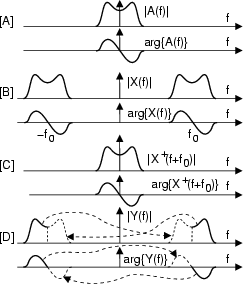Consideriamo un segnale
a![]() t
t![]() reale e limitato in banda,
con
A
reale e limitato in banda,
con
A![]() f
f![]() = A*
= A*![]() - f
- f![]() (grafico [A]), a simmetria
coniugata. Come già illustrato, la conoscenza di
A+
(grafico [A]), a simmetria
coniugata. Come già illustrato, la conoscenza di
A+![]() f
f![]() = A
= A![]() f
f![]() rectW
rectW![]() f -
f - ![]()
![]() è sufficiente a definire
a
è sufficiente a definire
a![]() t
t![]() in modo completo, in virtù
della simmetria coniugata. Se definiamo
x
in modo completo, in virtù
della simmetria coniugata. Se definiamo
x![]() t
t![]() = a
= a![]() t
t![]() cos
cos![]() t,
anch'esso reale, otteniamo che
X
t,
anch'esso reale, otteniamo che
X![]() f
f![]() [B], oltre ad essere
a simmetria coniugata rispetto all'origine, ha simmetria coniugata anche rispetto
ad f0:
X+
[B], oltre ad essere
a simmetria coniugata rispetto all'origine, ha simmetria coniugata anche rispetto
ad f0:
X+![]() f + f0
f + f0![]() =
= ![]() X+
X+![]() - f + f0
- f + f0![]()
![]() [C].
[C].

Una volta verificata l'esattezza del procedimento illustrato, che ci consente
di ricevere per intero
X![]() f
f![]() trasmettendone solo metà (cioè
Y
trasmettendone solo metà (cioè
Y![]() f
f![]() ), osserviamo che anche
Y
), osserviamo che anche
Y![]() f
f![]() è a
simmetria coniugata rispetto a zero (ossia
Y
è a
simmetria coniugata rispetto a zero (ossia
Y![]() f
f![]() = Y*
= Y*![]() - f
- f![]() ),
e quindi la sua antitrasformata
y
),
e quindi la sua antitrasformata
y![]() t
t![]() è reale, e dunque può
essere realmente trasmesso.
è reale, e dunque può
essere realmente trasmesso.
A parte il ``dettaglio'' di come ricostruire ``veramente''
X![]() f
f![]() a partire da
Y
a partire da
Y![]() f
f![]() , ci chiediamo: esiste una formula per
ottenere
y
, ci chiediamo: esiste una formula per
ottenere
y![]() t
t![]() in modo diretto a partire da
a
in modo diretto a partire da
a![]() t
t![]() ?
La risposta è positiva; per provarla occorre però affrontare alcune pagine di
teoria, che illustrano un metodo di rappresentazione (nel dominio del tempo)
per segnali modulati.
?
La risposta è positiva; per provarla occorre però affrontare alcune pagine di
teoria, che illustrano un metodo di rappresentazione (nel dominio del tempo)
per segnali modulati.